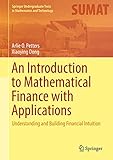An Introduction to Mathematical Finance with Applications [electronic resource] : Understanding and Building Financial Intuition / by Arlie O. Petters, Xiaoying Dong.
Material type: TextSeries: Springer Undergraduate Texts in Mathematics and TechnologyPublisher: New York, NY : Springer New York : Imprint: Springer, 2016Description: XVII, 483 p. 52 illus., 12 illus. in color. online resourceContent type:
TextSeries: Springer Undergraduate Texts in Mathematics and TechnologyPublisher: New York, NY : Springer New York : Imprint: Springer, 2016Description: XVII, 483 p. 52 illus., 12 illus. in color. online resourceContent type: - text
- computer
- online resource
- 9781493937837
- 519 23
- HB135-147
| Item type | Current library | Call number | Status | Date due | Barcode | Item holds | |
|---|---|---|---|---|---|---|---|
| E-BOOKS | ISI Library, Kolkata | Not for loan | EB1887 |
Preface -- 1. Preliminaries and Financial Markets -- 2. The Time Value of Money -- 3. Markowitz Portfolio Theory -- 4. Capital Market Theory and Portfolio Risk Measures -- 5. Binomial Trees and Security Pricing Modeling -- 6. Stochastic Calculus and Geometric Brownian Motion Model -- 7. Derivatives: Forwards, Futures, Swaps and Options -- 8. The BSM Model and European Option Pricing -- Index. .
This textbook aims to fill the gap between those that offer a theoretical treatment without many applications and those that present and apply formulas without appropriately deriving them. The balance achieved will give readers a fundamental understanding of key financial ideas and tools that form the basis for building realistic models, including those that may become proprietary. Numerous carefully chosen examples and exercises reinforce the student’s conceptual understanding and facility with applications. The exercises are divided into conceptual, application-based, and theoretical problems, which probe the material deeper. The book is aimed toward advanced undergraduates and first-year graduate students who are new to finance or want a more rigorous treatment of the mathematical models used within. While no background in finance is assumed, prerequisite math courses include multivariable calculus, probability, and linear algebra. The authors introduce additional mathematical tools as needed. The entire textbook is appropriate for a single year-long course on introductory mathematical finance. The self-contained design of the text allows for instructor flexibility in topics courses and those focusing on financial derivatives. Moreover, the text is useful for mathematicians, physicists, and engineers who want to learn finance via an approach that builds their financial intuition and is explicit about model building, as well as business school students who want a treatment of finance that is deeper but not overly theoretical.
There are no comments on this title.



























